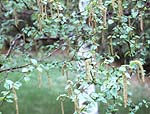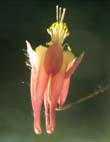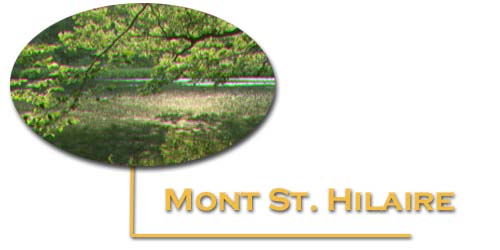Trees
Mont St-Hilaire is a maple-beech
climax forest, the final and most stable community in this forest
ecosystem. The co-dominant species which from the canopy are american
beech (Fagus grandifolia) and sugar maple (Acer saccharum),
two species which are highly shade tolerant at the seedling stage.
T he
Beech is commonly found on moist, well-drained slopes and ridges and
is usually mixed with other native hardwoods. Sites including stands
composed almost entirely of beech are also found. Beech is a tree
with persistent and acid leaves; they fall to the ground and decompose
very slowly. The sugar maple is one of the tallest hardwoods in Canada,
sometimes reaching a height of 40m and a diameter of 1.5m. The trunk
is usually long and straight in the forest, short and branched in
the open.
he
Beech is commonly found on moist, well-drained slopes and ridges and
is usually mixed with other native hardwoods. Sites including stands
composed almost entirely of beech are also found. Beech is a tree
with persistent and acid leaves; they fall to the ground and decompose
very slowly. The sugar maple is one of the tallest hardwoods in Canada,
sometimes reaching a height of 40m and a diameter of 1.5m. The trunk
is usually long and straight in the forest, short and branched in
the open.
Hickory, an indicator species
for a healthy, stable and old forest, occurs throughout the mountain but
does not form stands.
In some areas the mature forest
is being rejuvenated by hemlock (Tsuga canadensis). Hemlock
seedlings require shade provided by other trees for growth to occur.
The eastern hemlock is a medium-sized tree, 20m in height and 50-60cm.
in diameter. This tree is often mixed with white pine, spruces,
balsam fir and various hardwoods. Birch trees are characteristically
found at the edge of forest where they lean towards the light.
The white birch (Betula
papyrifera)is a species that prefers light; it is found in open
areas and has difficulty reseeding in the shade and so is found
in the open or at the edge of the forest. White birch are usually
associated with young forests because they need a lot of sun. The
grey birch (Betula populifolia) is usually found on dry gravelly
or sandy soils and is often one of the first trees to spring up
after a forest fire. It is a small tree and rarely grows over 9m
tall or 15cm in diameter. The yellow birch (Betula alleghaniensis)
is the largest of Canada's birches. The average tree is 20m high
and 60cm in diameter. It grows on a wide range of sites.
On wet sites in the valleys
where tree growth is slow the common species include red maple,
black ash, shagbark hickory and basswood. Red maple (Acer rubrum)
attains a height of 25m with a maximum trunk diameter of over 1m
when growing in moist soils. Although a common tree throughout its
range, it is not plentiful at Mont St-Hilaire. The tree is distinctive
for it red twigs, winter buds, flowers and fruits and leaf stems.
The basswood, also known as linden (Tilia americana), is
20m in height and 60-75cm in diameter. It prefers a deep loam soil
on low slopes and along streams, but is also found on high rocky
ridges.
The valleys between the eleven
peaks are wind corridors and mark areas where there is constant renewal
and regrowth on the slopes. The vegetation of the summits are also affected
by wind and the most common species is the dwarfed red oak.
The attractive striped maple,
or moosewood (Acer pennsylvanicum), is often found in the
understorey associated with beech. Moosewood has no commercial value
for wood but its leaf litter is very high in nutrients like potassium
and calcium. This tree is a tall shrub or small tree, commonly 3-6m
in height. It prefers cool moist soils on northern slopes and in
valleys where it is protected from direct sunlight. At Mont St-Hilaire
it forms a large part of the shrubby understory beneath mixed stands
of beech and sugar maple. The buds and twigs provide winter food
for deer and moose and the latter eat the leaves in summer.
The Mountain maple (Acer
spicatum)is a small tree or shrub rarely more than7.5m in height
and 12-18cm in diameter. At Mont St-Hilaire it prefers rich soils
on moist, rocky slopes and flats, and along small streams, where
it frequently forms the major part of the shrubby undergrowth. It
is rarely found growing in the open. The tree prevents erosion on
rocky slopes because the root system is very shallow.
Red ash (Fraxinus
pennsylvanica) is commonly found on moist sites along streams,
on the margins of swamps and on hillsides, where it grows with other
hardwoods.
Red oak (Quercas rubra
var. borealis)is a large tree,18-24m in height and 60cm-1m in
diameter. It is a very rapid growing oak and will do well on a variety
of soils. It is only moderately tolerant of shade and is often found
on sandy loam or rocky sites. Red oak covers the summits of Pain
du Sucre and Dieppe but as a low and scrubby dwarf.
The Pin or Fire Cherry
(Prunus pennsylvanica)is a small tree, 3-8m high and 10-20cm
in diameter. On Mont St-Hilaire it is found on new clearings and
on burned-over areas in a wide variety of soils from dry sand to
wet loams. It is very intolerant of shade. The tree is quite useful
in preventing erosion on newly cleared forest land and in providing
a light shade for the seedlings of more tolerant species.
The eastern white cedar
(Thuja occidentalis) is a small tree averaging about 13m
in height and 30cm in diameter. At Mont St-Hilaire this tree is
commonly found near swamps, around springs and lakes and on similar
wet sites but it will also thrive on the thin, often dry, soil of
limestone ridges.
The eastern white pine
(Pinus strobus) is th e
tallest and most stately of all conifers in Eastern Canada. It sometimes
reaches a height of 55m and a diameter of 1.5m It will grow on a
wide range of sites from dry sandy ridges to wet sphagnum bogs,
but does best on a moist, sandy soil. At Mont St-Hilaire it reaches
its greatest size on rich loams with eastern hemlock, yellow birch
and sugar maple.
e
tallest and most stately of all conifers in Eastern Canada. It sometimes
reaches a height of 55m and a diameter of 1.5m It will grow on a
wide range of sites from dry sandy ridges to wet sphagnum bogs,
but does best on a moist, sandy soil. At Mont St-Hilaire it reaches
its greatest size on rich loams with eastern hemlock, yellow birch
and sugar maple.
The apples, cherries,
plums, hawthorns, serviceberries and mountain ashes are all members
of the rose family of which the apples are well-known and widely
distributed representatives. About 25 species of apple are known.
The common apple (Malus pumila) has been introduced into
Canada for its fruit and is now naturalized under the name of wild
apple in many parts of the conntry. It is the parent of many of
the present-day cultivated apples.
Plants
Mont St-Hilaire  showcases
a total of 551 different taxa of plants. Of these 551 taxa, 34 are
trees, 65 are shrubs, 6 are lianas, and 421 are herbs. 23 species
are more or less restricted to aquatic environments.
showcases
a total of 551 different taxa of plants. Of these 551 taxa, 34 are
trees, 65 are shrubs, 6 are lianas, and 421 are herbs. 23 species
are more or less restricted to aquatic environments.
The largest family represented
is the Compositae (11%), followed by Rosacae (7%), Cyperaceae (7%), Graminae
(7%). The ferns, including members of three families, number 38 species
(6%).
Mont St-Hilaire occupies a
central location between the Northern Conifer-Hardwood/Northern Conifer
regions of eastern N.A and the boreal forest further north.
The most common plants in the
understorey and highly visible in the early spring when they flower include
the moccasin flower, yellow lady's slipper, the trillium and the wood
violets. In late summer the marsh-touch-me-not or jewelweed are very common
in the wetter areas.
248 Lichen and Moss
taxa are found on Mont St-Hilaire. Lichen are a combination
of algae and fungi that live on and break down bare rocks, creating
a substrate for plants. Mosses are primitive plants often found as
a rich carpet over ground and rocks. Generally anonymous, properly
identifying lichen and moss usually requires an expert and many lichen
species can only be idenified by chemical composition. Although not
as difficult to identify, mosses are rarely identified to species.
Moss genera with the most species are:
Brachythecium
Mnium
Plagiothecium
Fissidens
Dicranum
Bryum
Sphagnum
Thuidium
Hepatic genera:
Calypogeia
Cephalozia
Jungermannia
Lophocolea
Porella
Ptilidium
Horsetails,
also known as rushes, are usually found in or on the banks of streams,
but they grow in many disturbed areas as well, such as at the edges
of roads and paths. Seven species of horsetails are found at Mont
St-Hilaire.
field horsetail (Equisetum
arvense)
water horsetail (Equisetum
fluviatile)
great scouring-rush (Equisetum
hyemale)
meadow horsetail (Equisetum
pratense)
dwarf scouring-rush (Equisitum
scirpoides)
woodland horsetail (Equisetum
sylvaticum)
variegated scouring-rush
(Equisitum variegatum)
Many species of clubmoss
look like miniature trees, and when a large poplulation is found it
resembles a miniature forest. Quite often these populations are formed
by a single individual that sends out runners under the leaf litter
which sprout up every few centimetres.
flattened clubmoss (Diphasiastrum
digitatum)
three-spiked clubmoss
(Diphasiastrum tristachyum)
shining clubmoss (Huperzia
lucidula)
stiff clubmoss (Lycopodium
annotinum)
running clubmoss (Lycopodium
clavatum)
tree clubmoss (Lycopodium
dendroideum)
tree clubmoss (Lycopodium
obscurum)

